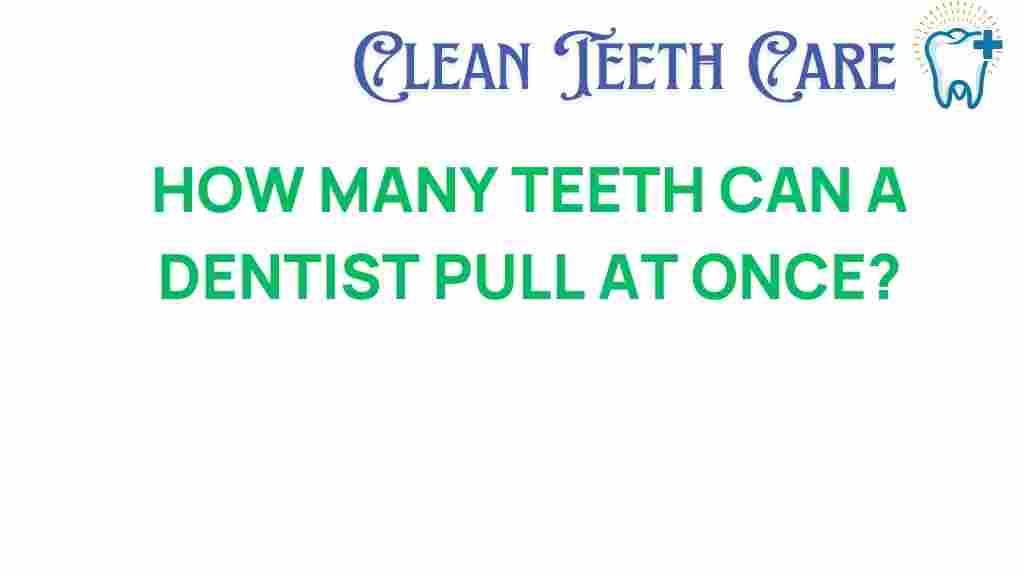The Limitations of Dentistry: How Many Teeth Can Be Extracted in One Visit?
Dentistry plays a crucial role in maintaining our oral health. Among the various dental procedures, tooth extraction is one of the most common. However, patients often wonder about the limitations of dentistry, particularly regarding how many teeth can be extracted in one visit. This article delves into the factors influencing tooth removal, the importance of patient care, and common dental myths surrounding the topic.
Understanding Tooth Extraction
Tooth extraction is a dental procedure that involves the removal of a tooth from its socket in the bone. This procedure may be necessary for various reasons, including:
- Severe tooth decay
- Gum disease
- Impacted teeth (such as wisdom teeth)
- Overcrowding in the mouth
- Infection
Before proceeding with a tooth extraction, a dentist will evaluate the patient’s oral health, review their medical history, and possibly take X-rays to determine the best course of action.
Factors Affecting the Number of Teeth Extracted
Several factors influence how many teeth a dentist can safely extract in one visit. Understanding these factors can help patients make informed decisions about their dental care.
1. Patient’s Health Status
The overall health of the patient is a critical consideration. Patients with certain medical conditions, such as:
- Heart conditions
- Diabetes
- Blood disorders
may face increased risks during dental procedures. Dentists prioritize patient safety and may limit the number of extractions based on these health factors.
2. Complexity of the Extraction
Not all tooth extractions are the same. Simple extractions, where the tooth is visible and easily accessible, may allow for multiple teeth to be removed in one visit. Conversely, surgical extractions, typically involving impacted teeth, may require more time and care, limiting the number of teeth that can be extracted.
3. Patient Comfort and Recovery
Patient care is paramount in dentistry. Dentists strive to ensure that patients are comfortable throughout the procedure. Extracting too many teeth at once can lead to increased pain, swelling, and complications. Therefore, a dentist may recommend spacing out extractions to enhance recovery and reduce discomfort.
4. Time Constraints
Dental procedures are often time-sensitive. A thorough extraction process may take considerable time, especially if multiple teeth are involved. Dentists typically allocate a specific timeframe for appointments, influencing how many teeth can be extracted during a single visit.
Common Dental Myths About Tooth Extraction
There are several myths surrounding tooth extraction that can lead to misconceptions about dental procedures. Here are a few to clarify:
- Myth 1: All teeth can be extracted in one visit.
- Myth 2: Tooth extraction is always painful.
- Myth 3: Extracting teeth is a sign of poor dental health.
Understanding these myths helps patients approach their dental care with a clear mindset, allowing them to make informed decisions about their oral health.
Step-by-Step Process of Tooth Extraction
Here’s a brief overview of what to expect during a tooth extraction:
- Consultation: The dentist will examine your mouth and discuss your dental history.
- X-Rays: Imaging may be performed to assess the tooth’s position and the surrounding bone structure.
- Anesthesia: Local or general anesthesia will be administered to ensure you are comfortable.
- Extraction: The dentist will carefully remove the tooth using specialized instruments.
- Post-Extraction Care: Instructions for care will be given, including how to manage pain and promote healing.
Following these steps, it is important to adhere to your dentist’s recommendations for a smooth recovery.
Troubleshooting Tips for Post-Extraction Care
After a tooth extraction, proper care is essential to minimize complications. Here are some troubleshooting tips:
- Manage Pain: Use over-the-counter pain relievers as directed by your dentist.
- Control Bleeding: Bite down on gauze pads provided by your dentist to curb bleeding.
- Rest: Avoid strenuous activities for at least 24 hours post-extraction.
- Follow-Up: Attend any scheduled follow-up appointments to ensure proper healing.
- Watch for Signs of Infection: Be alert for swelling, fever, or unusual pain, and contact your dentist if these occur.
By following these tips, you can enhance your recovery process and ensure optimal oral health.
In conclusion, while dentistry offers essential services for maintaining oral health, there are limitations regarding how many teeth can be extracted in one visit. Factors such as the patient’s health, the complexity of the extraction, and the importance of patient care all play a significant role in determining the appropriate number of extractions.
By understanding these limitations, patients can approach tooth removal with realistic expectations and a better appreciation for the dental procedures involved. Always consult with your dentist about any concerns or questions regarding tooth extraction and other dental procedures.
For more information on dental safety and oral health practices, visit this resource. If you have questions about your specific dental care needs, don’t hesitate to reach out to your dentist.
Stay informed and proactive about your oral health to maintain a beautiful smile for years to come!
This article is in the category Treatments and created by CleanTeethCare Team
